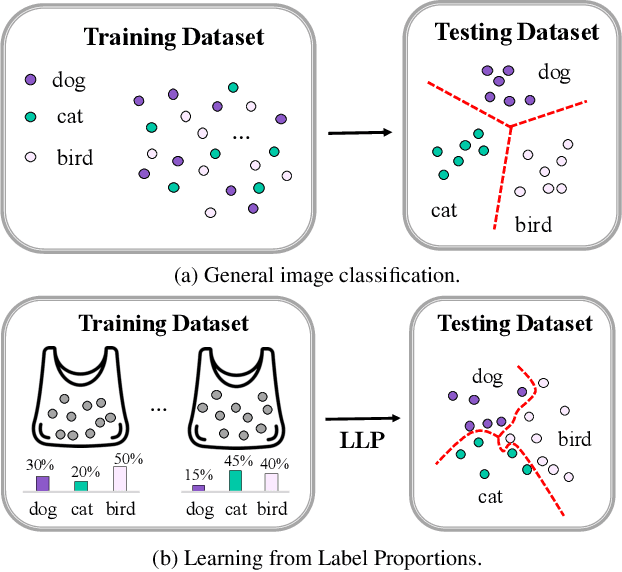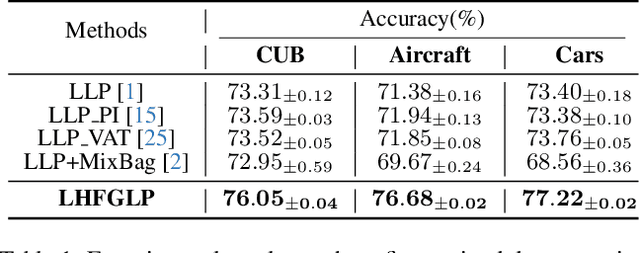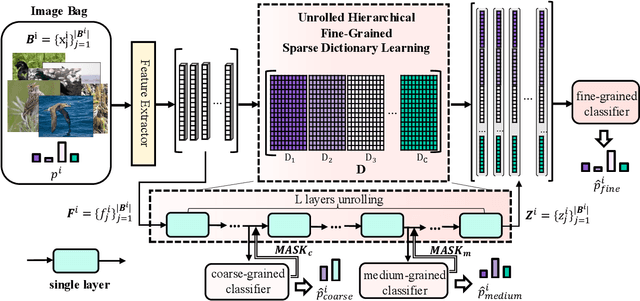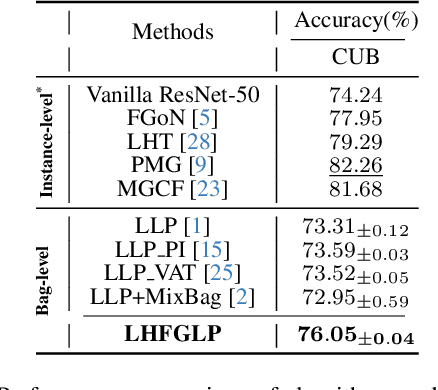Zhanyu Ma
Measurement-Constrained Sampling for Text-Prompted Blind Face Restoration
Nov 18, 2025Abstract:Blind face restoration (BFR) may correspond to multiple plausible high-quality (HQ) reconstructions under extremely low-quality (LQ) inputs. However, existing methods typically produce deterministic results, struggling to capture this one-to-many nature. In this paper, we propose a Measurement-Constrained Sampling (MCS) approach that enables diverse LQ face reconstructions conditioned on different textual prompts. Specifically, we formulate BFR as a measurement-constrained generative task by constructing an inverse problem through controlled degradations of coarse restorations, which allows posterior-guided sampling within text-to-image diffusion. Measurement constraints include both Forward Measurement, which ensures results align with input structures, and Reverse Measurement, which produces projection spaces, ensuring that the solution can align with various prompts. Experiments show that our MCS can generate prompt-aligned results and outperforms existing BFR methods. Codes will be released after acceptance.
Seeing Through the Rain: Resolving High-Frequency Conflicts in Deraining and Super-Resolution via Diffusion Guidance
Nov 16, 2025Abstract:Clean images are crucial for visual tasks such as small object detection, especially at high resolutions. However, real-world images are often degraded by adverse weather, and weather restoration methods may sacrifice high-frequency details critical for analyzing small objects. A natural solution is to apply super-resolution (SR) after weather removal to recover both clarity and fine structures. However, simply cascading restoration and SR struggle to bridge their inherent conflict: removal aims to remove high-frequency weather-induced noise, while SR aims to hallucinate high-frequency textures from existing details, leading to inconsistent restoration contents. In this paper, we take deraining as a case study and propose DHGM, a Diffusion-based High-frequency Guided Model for generating clean and high-resolution images. DHGM integrates pre-trained diffusion priors with high-pass filters to simultaneously remove rain artifacts and enhance structural details. Extensive experiments demonstrate that DHGM achieves superior performance over existing methods, with lower costs.
SpecGen: Neural Spectral BRDF Generation via Spectral-Spatial Tri-plane Aggregation
Aug 24, 2025



Abstract:Synthesizing spectral images across different wavelengths is essential for photorealistic rendering. Unlike conventional spectral uplifting methods that convert RGB images into spectral ones, we introduce SpecGen, a novel method that generates spectral bidirectional reflectance distribution functions (BRDFs) from a single RGB image of a sphere. This enables spectral image rendering under arbitrary illuminations and shapes covered by the corresponding material. A key challenge in spectral BRDF generation is the scarcity of measured spectral BRDF data. To address this, we propose the Spectral-Spatial Tri-plane Aggregation (SSTA) network, which models reflectance responses across wavelengths and incident-outgoing directions, allowing the training strategy to leverage abundant RGB BRDF data to enhance spectral BRDF generation. Experiments show that our method accurately reconstructs spectral BRDFs from limited spectral data and surpasses state-of-the-art methods in hyperspectral image reconstruction, achieving an improvement of 8 dB in PSNR. Codes and data will be released upon acceptance.
MedReasoner: Reinforcement Learning Drives Reasoning Grounding from Clinical Thought to Pixel-Level Precision
Aug 11, 2025Abstract:Accurately grounding regions of interest (ROIs) is critical for diagnosis and treatment planning in medical imaging. While multimodal large language models (MLLMs) combine visual perception with natural language, current medical-grounding pipelines still rely on supervised fine-tuning with explicit spatial hints, making them ill-equipped to handle the implicit queries common in clinical practice. This work makes three core contributions. We first define Unified Medical Reasoning Grounding (UMRG), a novel vision-language task that demands clinical reasoning and pixel-level grounding. Second, we release U-MRG-14K, a dataset of 14K samples featuring pixel-level masks alongside implicit clinical queries and reasoning traces, spanning 10 modalities, 15 super-categories, and 108 specific categories. Finally, we introduce MedReasoner, a modular framework that distinctly separates reasoning from segmentation: an MLLM reasoner is optimized with reinforcement learning, while a frozen segmentation expert converts spatial prompts into masks, with alignment achieved through format and accuracy rewards. MedReasoner achieves state-of-the-art performance on U-MRG-14K and demonstrates strong generalization to unseen clinical queries, underscoring the significant promise of reinforcement learning for interpretable medical grounding.
PolarAnything: Diffusion-based Polarimetric Image Synthesis
Jul 24, 2025Abstract:Polarization images facilitate image enhancement and 3D reconstruction tasks, but the limited accessibility of polarization cameras hinders their broader application. This gap drives the need for synthesizing photorealistic polarization images. The existing polarization simulator Mitsuba relies on a parametric polarization image formation model and requires extensive 3D assets covering shape and PBR materials, preventing it from generating large-scale photorealistic images. To address this problem, we propose PolarAnything, capable of synthesizing polarization images from a single RGB input with both photorealism and physical accuracy, eliminating the dependency on 3D asset collections. Drawing inspiration from the zero-shot performance of pretrained diffusion models, we introduce a diffusion-based generative framework with an effective representation strategy that preserves the fidelity of polarization properties. Experiments show that our model generates high-quality polarization images and supports downstream tasks like shape from polarization.
FairHuman: Boosting Hand and Face Quality in Human Image Generation with Minimum Potential Delay Fairness in Diffusion Models
Jul 03, 2025Abstract:Image generation has achieved remarkable progress with the development of large-scale text-to-image models, especially diffusion-based models. However, generating human images with plausible details, such as faces or hands, remains challenging due to insufficient supervision of local regions during training. To address this issue, we propose FairHuman, a multi-objective fine-tuning approach designed to enhance both global and local generation quality fairly. Specifically, we first construct three learning objectives: a global objective derived from the default diffusion objective function and two local objectives for hands and faces based on pre-annotated positional priors. Subsequently, we derive the optimal parameter updating strategy under the guidance of the Minimum Potential Delay (MPD) criterion, thereby attaining fairness-ware optimization for this multi-objective problem. Based on this, our proposed method can achieve significant improvements in generating challenging local details while maintaining overall quality. Extensive experiments showcase the effectiveness of our method in improving the performance of human image generation under different scenarios.
Towards Privacy-Preserving Fine-Grained Visual Classification via Hierarchical Learning from Label Proportions
May 29, 2025



Abstract:In recent years, Fine-Grained Visual Classification (FGVC) has achieved impressive recognition accuracy, despite minimal inter-class variations. However, existing methods heavily rely on instance-level labels, making them impractical in privacy-sensitive scenarios such as medical image analysis. This paper aims to enable accurate fine-grained recognition without direct access to instance labels. To achieve this, we leverage the Learning from Label Proportions (LLP) paradigm, which requires only bag-level labels for efficient training. Unlike existing LLP-based methods, our framework explicitly exploits the hierarchical nature of fine-grained datasets, enabling progressive feature granularity refinement and improving classification accuracy. We propose Learning from Hierarchical Fine-Grained Label Proportions (LHFGLP), a framework that incorporates Unrolled Hierarchical Fine-Grained Sparse Dictionary Learning, transforming handcrafted iterative approximation into learnable network optimization. Additionally, our proposed Hierarchical Proportion Loss provides hierarchical supervision, further enhancing classification performance. Experiments on three widely-used fine-grained datasets, structured in a bag-based manner, demonstrate that our framework consistently outperforms existing LLP-based methods. We will release our code and datasets to foster further research in privacy-preserving fine-grained classification.
DriveRX: A Vision-Language Reasoning Model for Cross-Task Autonomous Driving
May 27, 2025Abstract:Autonomous driving requires real-time, robust reasoning across perception, prediction, planning, and behavior. However, conventional end-to-end models fail to generalize in complex scenarios due to the lack of structured reasoning. Recent vision-language models (VLMs) have been applied to driving tasks, but they typically rely on isolated modules and static supervision, limiting their ability to support multi-stage decision-making. We present AutoDriveRL, a unified training framework that formulates autonomous driving as a structured reasoning process over four core tasks. Each task is independently modeled as a vision-language question-answering problem and optimized using task-specific reward models, enabling fine-grained reinforcement signals at different reasoning stages. Within this framework, we train DriveRX, a cross-task reasoning VLM designed for real-time decision-making. DriveRX achieves strong performance on a public benchmark, outperforming GPT-4o in behavior reasoning and demonstrating robustness under complex or corrupted driving conditions. Our analysis further highlights the impact of vision encoder design and reward-guided reasoning compression. We will release the AutoDriveRL framework and the DriveRX model to support future research.
Multimodal Conditional Information Bottleneck for Generalizable AI-Generated Image Detection
May 21, 2025Abstract:Although existing CLIP-based methods for detecting AI-generated images have achieved promising results, they are still limited by severe feature redundancy, which hinders their generalization ability. To address this issue, incorporating an information bottleneck network into the task presents a straightforward solution. However, relying solely on image-corresponding prompts results in suboptimal performance due to the inherent diversity of prompts. In this paper, we propose a multimodal conditional bottleneck network to reduce feature redundancy while enhancing the discriminative power of features extracted by CLIP, thereby improving the model's generalization ability. We begin with a semantic analysis experiment, where we observe that arbitrary text features exhibit lower cosine similarity with real image features than with fake image features in the CLIP feature space, a phenomenon we refer to as "bias". Therefore, we introduce InfoFD, a text-guided AI-generated image detection framework. InfoFD consists of two key components: the Text-Guided Conditional Information Bottleneck (TGCIB) and Dynamic Text Orthogonalization (DTO). TGCIB improves the generalizability of learned representations by conditioning on both text and class modalities. DTO dynamically updates weighted text features, preserving semantic information while leveraging the global "bias". Our model achieves exceptional generalization performance on the GenImage dataset and latest generative models. Our code is available at https://github.com/Ant0ny44/InfoFD.
CineTechBench: A Benchmark for Cinematographic Technique Understanding and Generation
May 21, 2025



Abstract:Cinematography is a cornerstone of film production and appreciation, shaping mood, emotion, and narrative through visual elements such as camera movement, shot composition, and lighting. Despite recent progress in multimodal large language models (MLLMs) and video generation models, the capacity of current models to grasp and reproduce cinematographic techniques remains largely uncharted, hindered by the scarcity of expert-annotated data. To bridge this gap, we present CineTechBench, a pioneering benchmark founded on precise, manual annotation by seasoned cinematography experts across key cinematography dimensions. Our benchmark covers seven essential aspects-shot scale, shot angle, composition, camera movement, lighting, color, and focal length-and includes over 600 annotated movie images and 120 movie clips with clear cinematographic techniques. For the understanding task, we design question answer pairs and annotated descriptions to assess MLLMs' ability to interpret and explain cinematographic techniques. For the generation task, we assess advanced video generation models on their capacity to reconstruct cinema-quality camera movements given conditions such as textual prompts or keyframes. We conduct a large-scale evaluation on 15+ MLLMs and 5+ video generation models. Our results offer insights into the limitations of current models and future directions for cinematography understanding and generation in automatically film production and appreciation. The code and benchmark can be accessed at https://github.com/PRIS-CV/CineTechBench.
 Add to Chrome
Add to Chrome Add to Firefox
Add to Firefox Add to Edge
Add to Edge